The Specialized Sirrus X 3.0 emerges as a robust and versatile option in the realm of Specialized Hybrid Bikes, taking the essence of a fitness bike and injecting it with a ‘do-it-all’ spirit. This bike isn’t just about paved paths; its wide wheels and tires, coupled with a mountain bike-inspired riser bar, ensure it’s equally adept at navigating city streets and exploring off-the-beaten-path trails. However, in a competitive market, the Sirrus X 3.0 faces strong contenders vying for attention at a similar price point.
The Sirrus lineage is known for its hybrid nature, offering models with compact or step-through frames, smooth-rolling tires, and typically a 2x chainset. The Sirrus X series elevates this formula by incorporating 42mm gravel tires, a wider handlebar—by road bike standards—for enhanced off-road control, and a wide-ranging 1x drivetrain.
Riding the Sirrus X 3.0 is simply enjoyable, regardless of the terrain. My personal experiences, ranging from daily school commutes to leisurely explorations in wooded areas with my children, have consistently been a blast.
> Insuring a bike? Compare quotes from over 30 providers
Despite its 680mm handlebar, the steering remains agile, positioning the Sirrus X 3.0 as a surprisingly capable gravel companion. In many respects, it echoes the rigid mountain bikes of the late 80s and early 90s, offering a nostalgic yet modern riding experience.
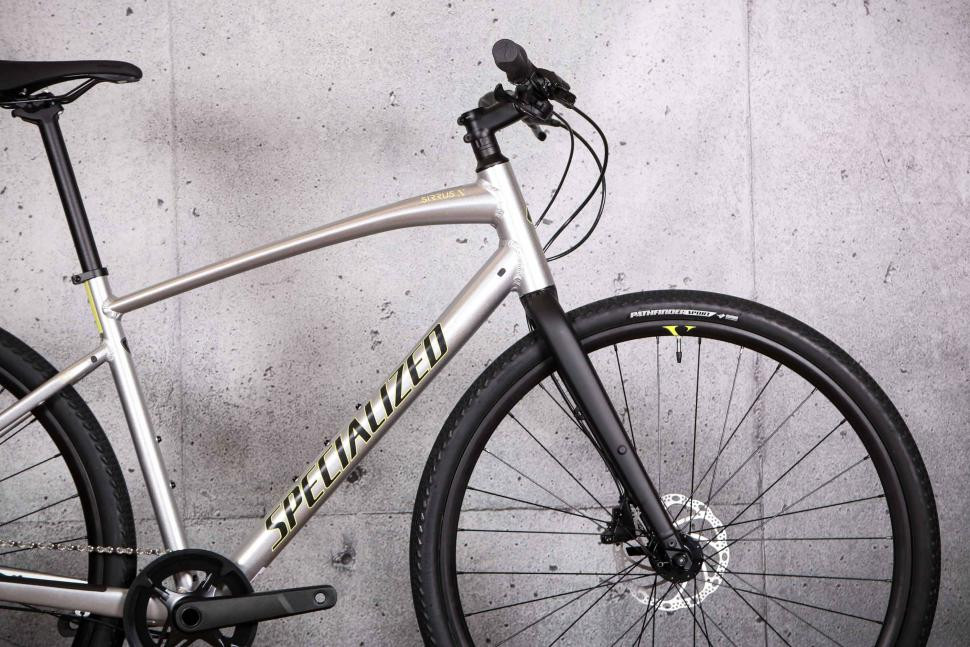 Specialized Sirrus X 3.0 Front View
Specialized Sirrus X 3.0 Front View
The Sirrus X 3.0 isn’t built for breakneck speed like a drop-bar road bike, but its stability shines when you’re in the mood for relaxed rides along scenic routes, perhaps with a couple of bar bags for added practicality. The forgiving front end and extended wheelbase contribute to a ride quality that encourages exploration and enjoyment of the surroundings.
During my longest ride, spanning approximately 2.5 hours and 35 miles across diverse surfaces—from smooth roads to varied hardpack byways and even some muddy trails—the Sirrus X 3.0 impressed. Even with firmly inflated tires, the ride quality remained commendable for an entry-level aluminum alloy frame and fork.
 Rider on Specialized Sirrus X 3.0 on Trail
Rider on Specialized Sirrus X 3.0 on Trail
The bike handles rough terrain with composure, effectively absorbing bumps and vibrations. While the flat bar setup provides fewer hand position options compared to drop bars, a feature that might take some getting used to for road cyclists, it contributes to the bike’s responsive and upright riding posture.
The 40t chainring combined with a 10-speed, 11-42t cassette delivers a gear range that rivals many 1x gravel bikes. This gearing helps offset the bike’s weight, although very steep inclines can still present a challenge.
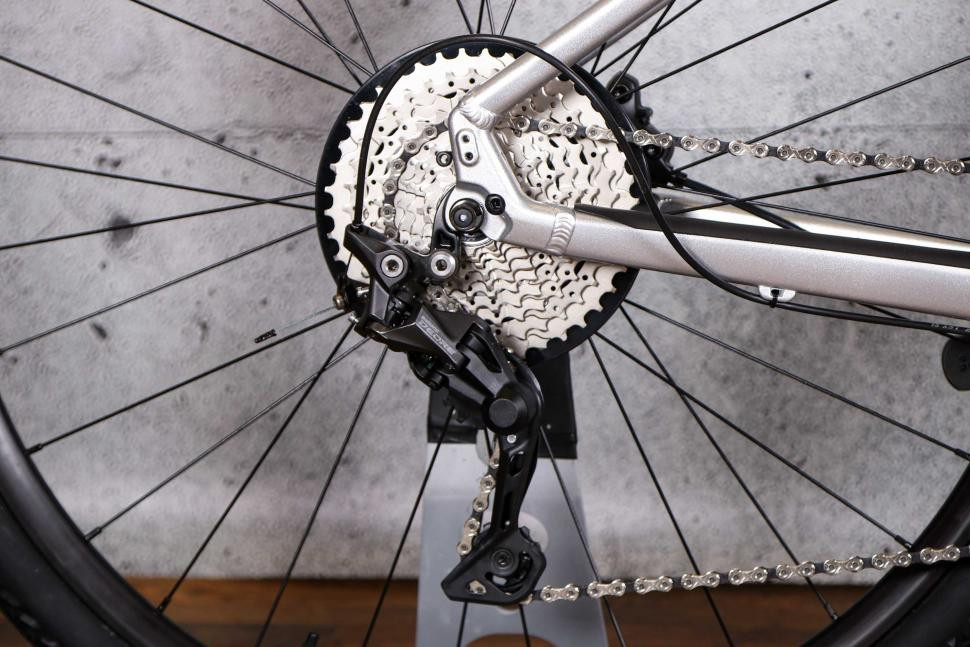 Specialized Sirrus X 3.0 Rear Derailleur and Cassette
Specialized Sirrus X 3.0 Rear Derailleur and Cassette
On paved roads, the Sirrus X 3.0 maintains a respectable cruising speed. Lower gears offer brisk acceleration from stops, and the bike’s nimble handling facilitates easy navigation through urban environments. The handlebar width, while beneficial for off-road control, slightly limits maneuverability through narrow gaps in traffic—though those accustomed to modern mountain bike bars might find it comparatively narrow.
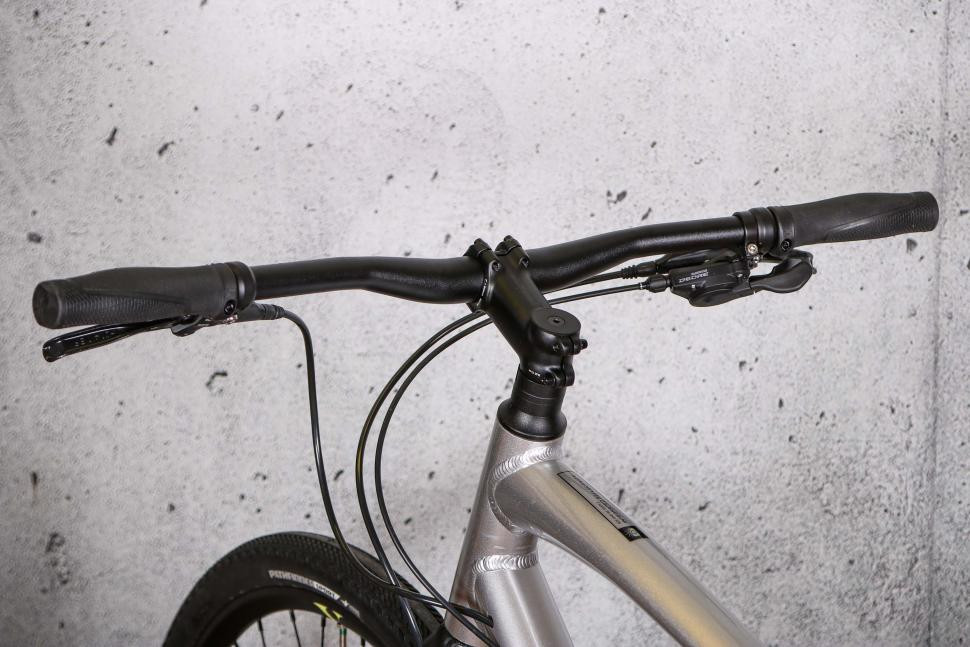 Specialized Sirrus X 3.0 Handlebar View
Specialized Sirrus X 3.0 Handlebar View
The upright riding position provides enhanced visibility in urban traffic, adding to the bike’s practicality for city commutes.
From a rider’s perspective, the Sirrus X is genuinely appealing. It exceeded expectations across various riding environments, feeling surprisingly agile and performing admirably even against headwinds. Its core strength lies in its versatility, a quality that Specialized has executed exceptionally well in this specialized hybrid bike.
Frame and Fork: Durable and Thoughtfully Designed
The Sirrus X frame employs Specialized’s A1 Premium Aluminum tubing, featuring butted construction—varying tube wall thickness for optimized strength and weight. Thicker ends at weld points and thinner mid-sections contribute to both durability and a degree of compliance for enhanced comfort.
The welds, while functional, have a somewhat industrial aesthetic, which aligns with the bike’s rugged character, particularly in the silver color option (also available in dark red).
 Specialized Sirrus X 3.0 Frame Size Detail
Specialized Sirrus X 3.0 Frame Size Detail
A subtle yet practical detail is the reflective Specialized logos on the downtube, appearing black in daylight but enhancing side visibility in low-light conditions.
 Specialized Sirrus X 3.0 Downtube with Reflective Logo
Specialized Sirrus X 3.0 Downtube with Reflective Logo
The downtube features three bottle cage bolt positions, allowing for adjustment when using frame bags, while the seat tube has standard dual bolts.
Mudguard and rack mounts are integrated into both the frame and fork, catering to riders seeking added utility. For those prioritizing these features, the Sirrus X EQ models come pre-equipped with mudguards, a rear rack (both compatible with Specialized’s Plug + Play system), and a dynamo front light.
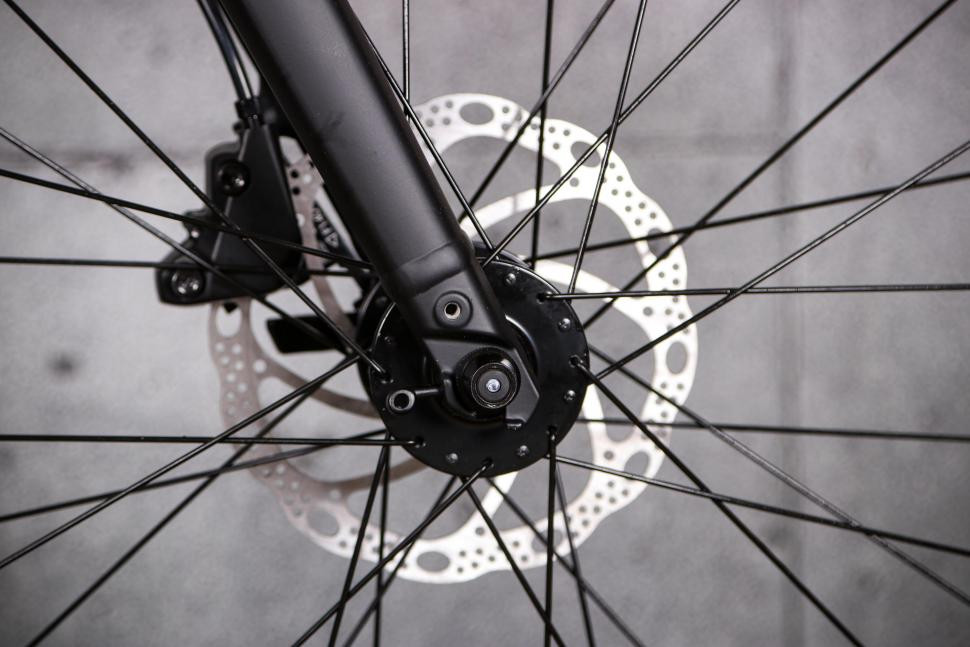 Specialized Sirrus X 3.0 Fork Detail with Mounts
Specialized Sirrus X 3.0 Fork Detail with Mounts
Both the frame and the full aluminum fork utilize flat-mounts for brake calipers and quick-release wheel axles with standard dropouts. While thru-axles are increasingly common with disc brakes, the Sirrus X’s intended use and performance levels do not necessitate the added stiffness and security they provide.
Geometry and Sizing: Adaptable and Comfortable
For riders accustomed to traditional road or gravel bike geometry—and frame sizing based on top tube length—sizing up from your usual size is recommended due to the Sirrus X’s relatively short stem. For example, the medium size tested features a 574mm effective top tube, approximately 20mm longer than a typical road or gravel bike for a rider of my size, yet the fit was spot-on.
Combined with an 80mm stem, the reach measures 398mm, identical to the Specialized Allez Sprint Comp road bike in a 56cm size. The stack height is notably taller at 593mm, thanks to the Sirrus X’s 180mm head tube.
 Specialized Sirrus X 3.0 Stem and Headset
Specialized Sirrus X 3.0 Stem and Headset
The front end geometry blends gravel-friendly elements, including a 71° head angle, a 395mm fork length, and a 51mm rake/offset. The wheelbase measures 1,067mm, contributing to the bike’s stable handling.
Complementing the standard frame design, Specialized also offers a range of step-through Sirrus X models, enhancing accessibility for a broader range of riders.
Finishing Kit: Dependable Shimano Components
The Sirrus X 3.0 predominantly features a Shimano componentry, with Deore badging on the cassette, rear derailleur, and shifters. This 10-speed groupset pairs an 11-42t cassette with a 40t narrow-wide chainring on an unbranded alloy crankset.
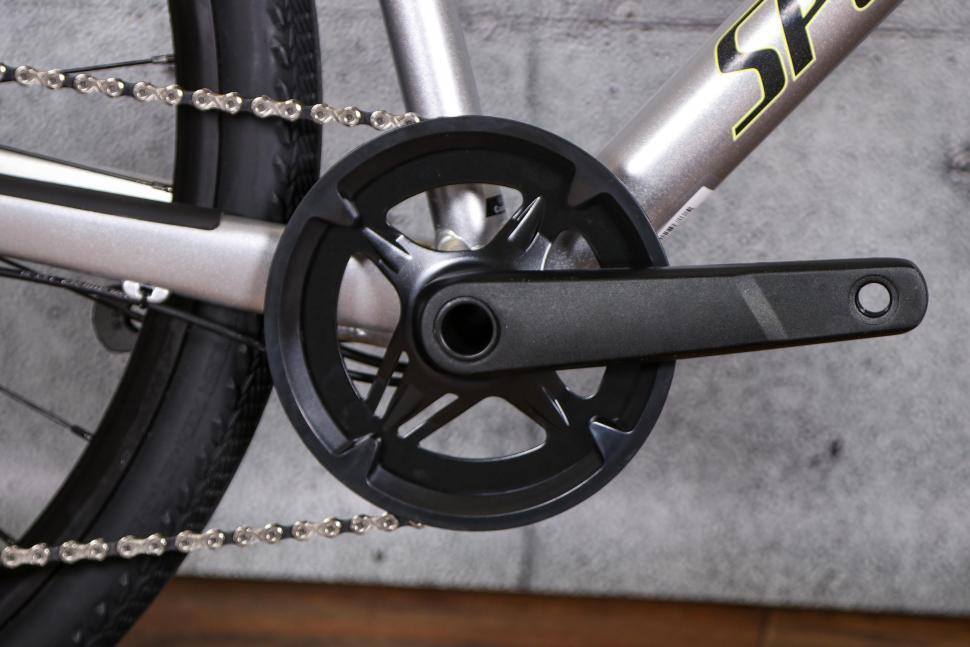 Specialized Sirrus X 3.0 Crankset and Pedals
Specialized Sirrus X 3.0 Crankset and Pedals
This setup provides a versatile gear range suitable for varied riding conditions, though it has limitations at both extremes. On flat roads, only the smaller sprockets are typically needed, while high-speed descents will quickly lead to spinning out.
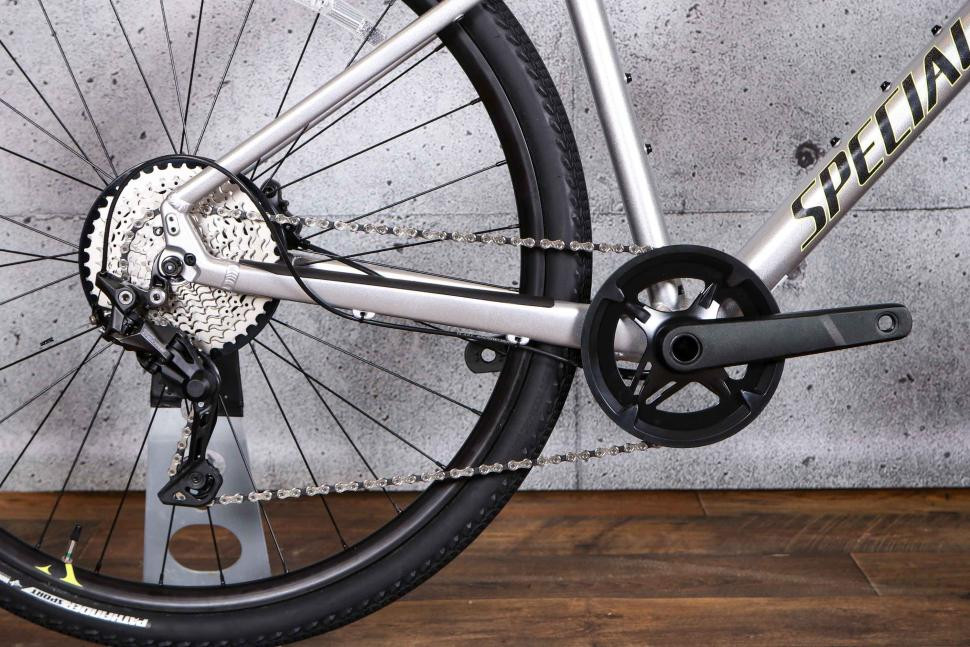 Specialized Sirrus X 3.0 Drivetrain Components
Specialized Sirrus X 3.0 Drivetrain Components
Off-road, the 40/42t low gear proves adequate for most climbs, although exceptionally steep ascents might necessitate lower gearing. Shifting performance remains consistent and smooth across the cassette, with ergonomically positioned lever buttons. A KMC chain and a threaded bottom bracket contribute to durability and wet-weather reliability.
For a specialized hybrid bike at this price point, the hydraulic disc brakes are a standout feature. Tektro HD-R280 hydraulic brakes with 160mm front and 140mm rear rotors deliver confident stopping power and good modulation, even with two-finger braking.
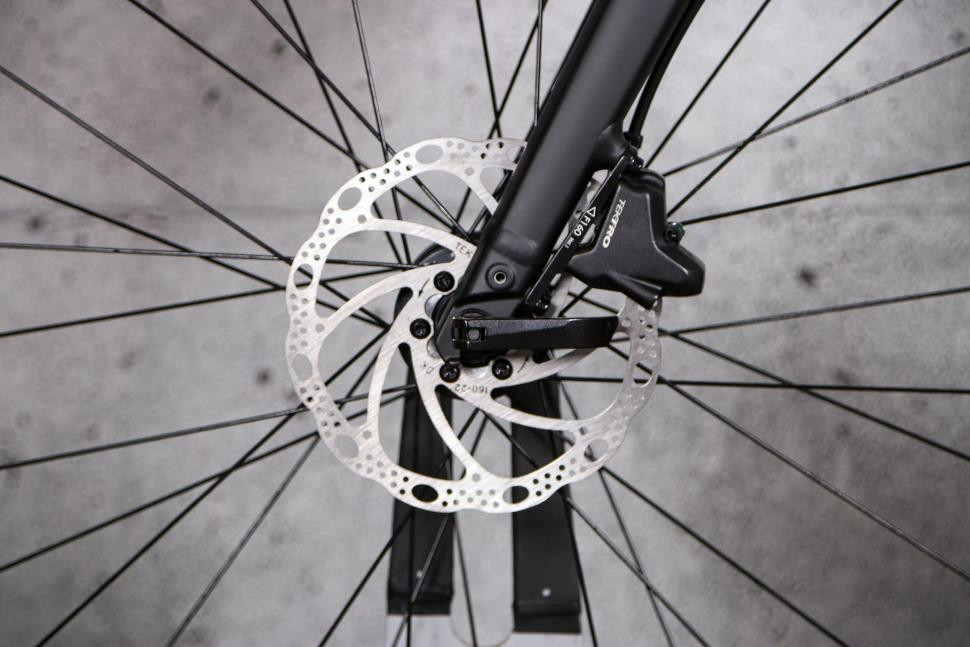 Specialized Sirrus X 3.0 Front Hydraulic Disc Brake
Specialized Sirrus X 3.0 Front Hydraulic Disc Brake
The remaining components are functional and reliable, including an alloy stem, seatpost, and handlebar. The 680mm wide handlebar on the medium size offers a 15mm rise and 9° backsweep. Specialized Neutralizer locking grips provide comfortable hand contact, especially considering the limited hand positions inherent to flat bars.
 Specialized Sirrus X 3.0 Handlebar Grips
Specialized Sirrus X 3.0 Handlebar Grips
The Bridge Sport saddle proved comfortable for the upright riding posture, offering adequate padding without feeling overly soft, which is beneficial when a significant portion of rider weight is supported by the saddle.
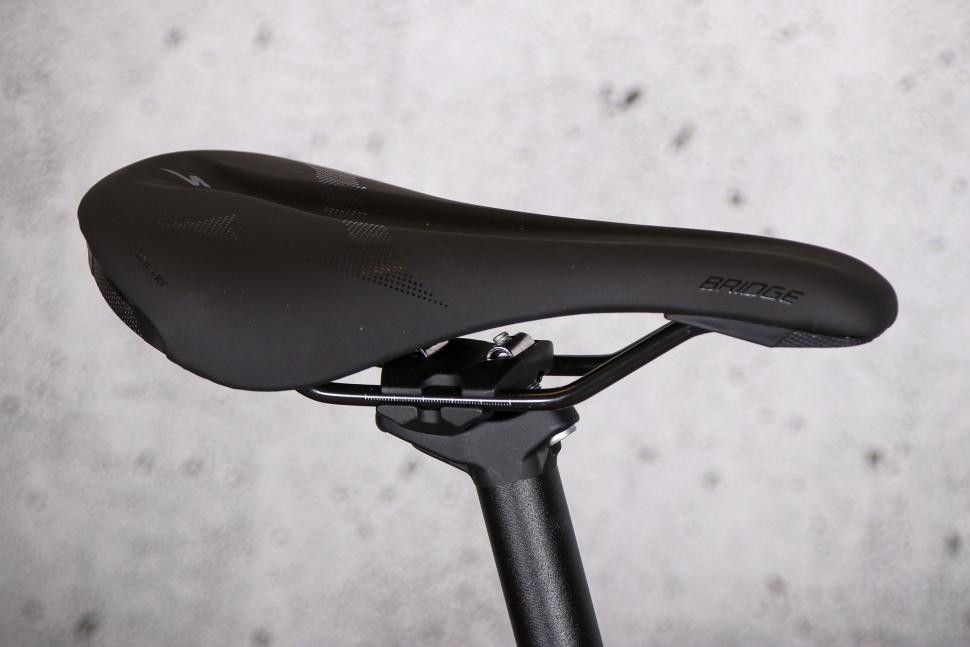 Specialized Sirrus X 3.0 Saddle Comfort
Specialized Sirrus X 3.0 Saddle Comfort
Wheels and Tyres: Robust and Versatile
The wheelset is practical and durable, featuring double-wall alloy rims with a 22mm depth and 21mm internal width, alloy hubs with loose ball bearings, 32 stainless steel spokes, and QR axles.
These wheels proved durable throughout testing, enduring rough gravel tracks without issue. While not exceptionally lightweight or performance-oriented, they are well-suited to the Sirrus X’s intended purpose as a versatile hybrid.
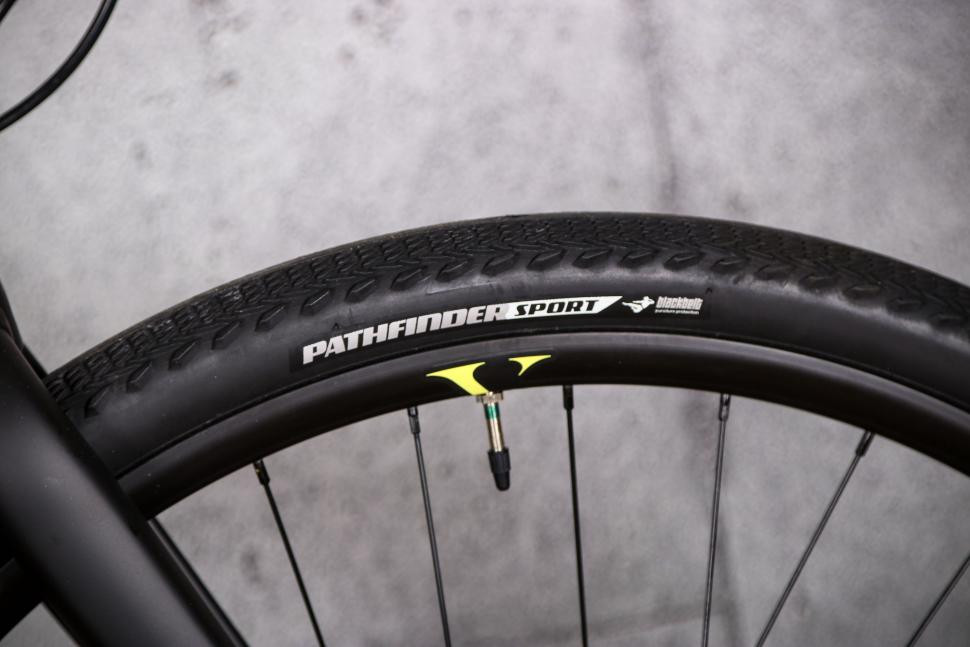 Specialized Sirrus X 3.0 Rim and Tire Detail
Specialized Sirrus X 3.0 Rim and Tire Detail
Specialized Pathfinder Sport 42mm tires are a highlight, offering a good balance of road rolling efficiency and off-road capability on hardpacked surfaces. Their versatility allows seamless transitions between road, byways, and canal paths. While the minimal tread struggles in muddy conditions, for dry conditions they excel. Their robust wire bead construction prioritizes durability, effectively preventing punctures and cuts across varied terrain.
> 19 of the best 2021 gravel bikes & adventure road bikes
Value Proposition: Competitive in its Class
The Sirrus X 3.0, at its original price of £849, presented a compelling value proposition, slightly undercutting competitors like the Giant Escape 0 Disc (£899). While the Giant is lighter and features a carbon seatpost, the Sirrus X offers a more robust and arguably more visually appealing design. Both bikes share a 1x Deore groupset.
Compared to the Merida Speeder 200, a more road-oriented hybrid, and the Merida Crossway 300, a more off-road focused option, the Sirrus X 3.0 strikes a balance, offering versatility at a competitive price point. The current model, priced at £949 with a microSHIFT TrailTrigger Pro 9-speed setup, represents a price increase, yet the Deore-equipped version remains available in certain sizes and offers excellent value.
Overall Assessment: A True Hybrid Performer
The Sirrus X 3.0 effectively bridges the gap between a traditional hybrid and a hardtail mountain bike, offering remarkable versatility for commuters, fitness enthusiasts, and recreational riders alike. Its ability to accommodate 42mm tires enhances its off-road capabilities, making it a capable companion beyond paved surfaces.
Verdict: A Versatile and Engaging Hybrid Bike
The Specialized Sirrus X 3.0 stands out as a “do-it-all” specialized hybrid bike with a touch of attitude, equally at home in urban environments and on off-road adventures.
road.cc test report
Make and model: Specialized Sirrus X 3.0
Size tested: Medium
About the bike
List the components used to build up the bike.
DRIVETRAIN
Chainrings: 40T
Cassette: Shimano Deore, 10spd, 11-42t
Rear Derailleur: Shimano Deore M4120, SGS, 10-speed
Shift Levers: Shimano Deore M4100, 10-speed
Bottom Bracket: Threaded BSA 68mm
Crankset: Forged aluminum arms, 2-piece, 24mm spindle, Narrow-wide steel chainring
Chain: KMC X10, 10-speed w/ reusable Missing Link
COCKPIT
SeatPost: Alloy, 12mm offset, 2-bolt clamp, 27.2mm
Handlebars: Stout Mini Rise, alloy, 9-degree backsweep, 15mm rise, 31.8mm
Seat Binder: Bolt-type, 31.8mm
Stem: Specialized, 3D-forged alloy, 4-bolt, 7-degree rise
Saddle: Bridge Sport, Steel rails, 155/143mm
Tape: Specialized Neutralizer, Body Geometry, locking grip
BRAKES
Rear Brake: Tektro HD-R280, hydraulic disc, resin pads, flat-mount, 140mm
Front Brake: Tektro HD-R280, hydraulic disc, resin pads, flat-mount, 160mm
WHEELS & TIRES
Inner Tubes: Presta, 40mm valve
Rear Hub: Alloy, 6-bolt disc, 8-/9-speed freehub, loose ball bearing, quick-release, 32h
Front Hub: Alloy, 6-bolt disc, loose ball bearing, quick-release, 32h
Rims: 700C disc, double-wall alloy, 22mm depth, 21mm internal width, 32h
Spokes: Stainless, 14g
Front Tire: Pathfinder Sport, 700×42
Rear Tire: Pathfinder Sport, 700×42
Tell us what the bike is for and who it’s aimed at. What do the manufacturers say about it? How does that compare to your own feelings about the bike?
Specialized describes the Sirrus X as “your ticket to riding more, and to places you never imagined possible…a comfortable, capable, ‘let’s do stuff’ kind of bike that will inspire you to ride more than you ever have before.” They emphasize its confidence-inspiring tires, slightly upright riding position, intuitive 1x drivetrain, and ample mounts for racks and fenders, positioning it as a versatile partner for both pavement and gravel. Specialized also highlights the ergonomic comfort features of the saddle, handgrips, and pedals.
My experience aligns closely with Specialized’s description. The Sirrus X 3.0 proved to be a truly versatile bike, adept at handling a wide range of riding scenarios, from school runs to canal path touring, light gravel trails, and country lane explorations.
Where does this model sit in the range? Tell us briefly about the cheaper options and the more expensive options
The Sirrus X 3.0 is positioned within the mid-range of the Sirrus X lineup. The Sirrus X 2.0 sits below it, available in both standard and step-through frame options, offering a more budget-friendly entry point. Above the 3.0 is the Sirrus X 4.0, priced at £1,299, which upgrades to an 11-speed groupset for enhanced performance. Additionally, EX models are available in the 3.0 (Step Through) and 4.0 configurations, incorporating practical additions like racks and dynamo lights for enhanced utility and convenience.
Frame and fork
Overall rating for frame and fork: 8/10
Tell us about the build quality and finish of the frame and fork?
The frame and fork exhibit quality construction with a durable finish, enhanced by reflective decals that improve visibility in low-light conditions.
Tell us about the materials used in the frame and fork?
Frame: Specialized A1 Premium Aluminum, Fitness Geometry, butted tubing, internal cable routing, flat-mount disc, quick-release, Plug + Play rack/fender mounts
Fork: A1 Premium Aluminum, flat-mount disc, Plug + Play fender mounts, low rider rack mounts, quick-release
Tell us about the geometry of the frame and fork?
The geometry is designed to be relaxed and comfortable for road riding, yet balanced and neutral for off-road excursions, offering a versatile riding experience.
How was the bike in terms of height and reach? How did it compare to other bikes of the same stated size?
The stack and reach dimensions provided a balanced riding position, suitable for both efficient riding and relaxed cruising. Compared to traditional road bikes, the Sirrus X 3.0 has a taller stack and shorter reach for a more upright posture.
Riding the bike
Was the bike comfortable to ride? Tell us how you felt about the ride quality.
Yes, the Sirrus X 3.0 is notably comfortable. The saddle is well-suited for an upright position, and the wide handlebar allows for varied arm positions. The frame and fork provide a decent ride quality for an entry-level aluminum alloy construction, effectively absorbing road imperfections.
Did the bike feel stiff in the right places? Did any part of the bike feel too stiff or too flexible?
The Sirrus X 3.0 provides adequate stiffness for its intended use, with no noticeable flex in critical areas. It strikes a good balance between stiffness for efficiency and compliance for comfort.
How did the bike transfer power? Did it feel efficient?
Power transfer is efficient overall, aided by the wide-range 1x groupset that allows for quick acceleration and maintains momentum on varied terrain.
Was there any toe-clip overlap with the front wheel? If so was it a problem?
No toe-clip overlap was observed.
How would you describe the steering? Was it lively neutral or unresponsive?
Steering is neutral on paved roads, providing predictable and stable handling, while offering a fun and responsive feel on off-road trails.
Tell us some more about the handling. How did the bike feel overall? Did it do particular things well or badly?
The Sirrus X 3.0 excels as a versatile all-rounder. Handling is slightly slower in urban settings due to the wider handlebar, but it instills confidence and composure at speed on loose surfaces. It handles various conditions well, fulfilling its design as a jack-of-all-trades.
Which components had the most effect (good or bad) on the bike’s comfort? would you recommend any changes?
The saddle significantly contributes to comfort in the upright riding position. No immediate component changes are necessary for comfort.
Which components had the most effect (good or bad) on the bike’s stiffness? would you recommend any changes?
No components exhibited undesirable flex. The current component selection appears well-matched to the bike’s stiffness characteristics.
Which components had the most effect (good or bad) on the bike’s efficiency? would you recommend any changes?
The 1x drivetrain and wide gear range enhance efficiency across varied terrain. No immediate component changes are recommended for efficiency at this price point.
Rate the bike for efficiency of power transfer: 8/10
Rate the bike for acceleration: 7/10
Rate the bike for sprinting: 6/10
Rate the bike for high speed stability: 7/10
Rate the bike for cruising speed stability: 8/10
Rate the bike for low speed stability: 8/10
Rate the bike for flat cornering: 8/10
Rate the bike for cornering on descents: 8/10
Rate the bike for climbing: 7/10
The drivetrain
Rate the drivetrain for performance: 8/10
Rate the drivetrain for durability: 8/10
Rate the drivetrain for weight: 7/10
Rate the drivetrain for value: 5/10
Tell us some more about the drivetrain. Anything you particularly did or didn’t like? Any components which didn’t work well together?
The Shimano Deore drivetrain performs reliably with crisp and precise shifting. The Tektro hydraulic brakes are a standout feature at this price, providing excellent stopping power and highlighting the value of flat-bar hydraulic setups. All components worked harmoniously.
Wheels and tyres
Rate the wheels for performance: 7/10
Rate the wheels for durability: 8/10
Rate the wheels for weight: 7/10
Rate the wheels for comfort: 7/10
Rate the wheels for value: 5/10
Tell us some more about the wheels.Did they work well in the conditions you encountered? Would you change the wheels? If so what for?
The wheelset is competent and durable, performing well both on and off-road. No wheel changes are immediately necessary, as they are well-suited for the bike’s intended use.
Rate the tyres for performance: 8/10
Rate the tyres for durability: 8/10
Rate the tyres for weight: 7/10
Rate the tyres for comfort: 7/10
Rate the tyres for value: 5/10
Tell us some more about the tyres. Did they work well in the conditions you encountered? Would you change the tyres? If so what for?
The Specialized Pathfinder Sport tires offer a good balance of road rolling efficiency and off-road grip on hardpack surfaces. They performed well in varied conditions encountered during testing. For more aggressive off-road riding in muddy conditions, a tire change to a more treaded option might be considered.
Controls
Rate the controls for performance: 7/10
Rate the controls for durability: 8/10
Rate the controls for weight: 7/10
Rate the controls for comfort: 7/10
Rate the controls for value: 5/10
Tell us some more about the controls. Any particularly good or bad components? How would the controls work for larger or smaller riders?
The wide handlebar provides enhanced control off-road, while slightly slowing steering response in urban environments. The saddle is comfortable for the upright riding position. Control components are generally well-suited for a range of rider sizes.
Your summary
Did you enjoy riding the bike? Yes
Would you consider buying the bike? Yes, it serves as an excellent daily bike for various purposes.
Would you recommend the bike to a friend? Yes
How does the price compare to that of similar bikes in the market, including ones recently tested on road.cc?
The Sirrus X 3.0 is priced competitively compared to similar hybrid bikes from Merida and Giant, although the specifications may not perfectly align with each competitor. The newer microSHIFT-equipped model represents a less competitive value proposition.
Rate the bike overall for performance: 7/10
Rate the bike overall for value: 5/10
Overall rating: 8/10
About the tester
Age: 42 Height: 180cm Weight: 76kg
I usually ride: This month’s test bike My best bike is: B’Twin Ultra CF draped in the latest bling test components
I’ve been riding for: Over 20 years I ride: Every day I would class myself as: Expert
I regularly do the following types of riding: time trialling, commuting, club rides, sportives, fixed/singlespeed,

